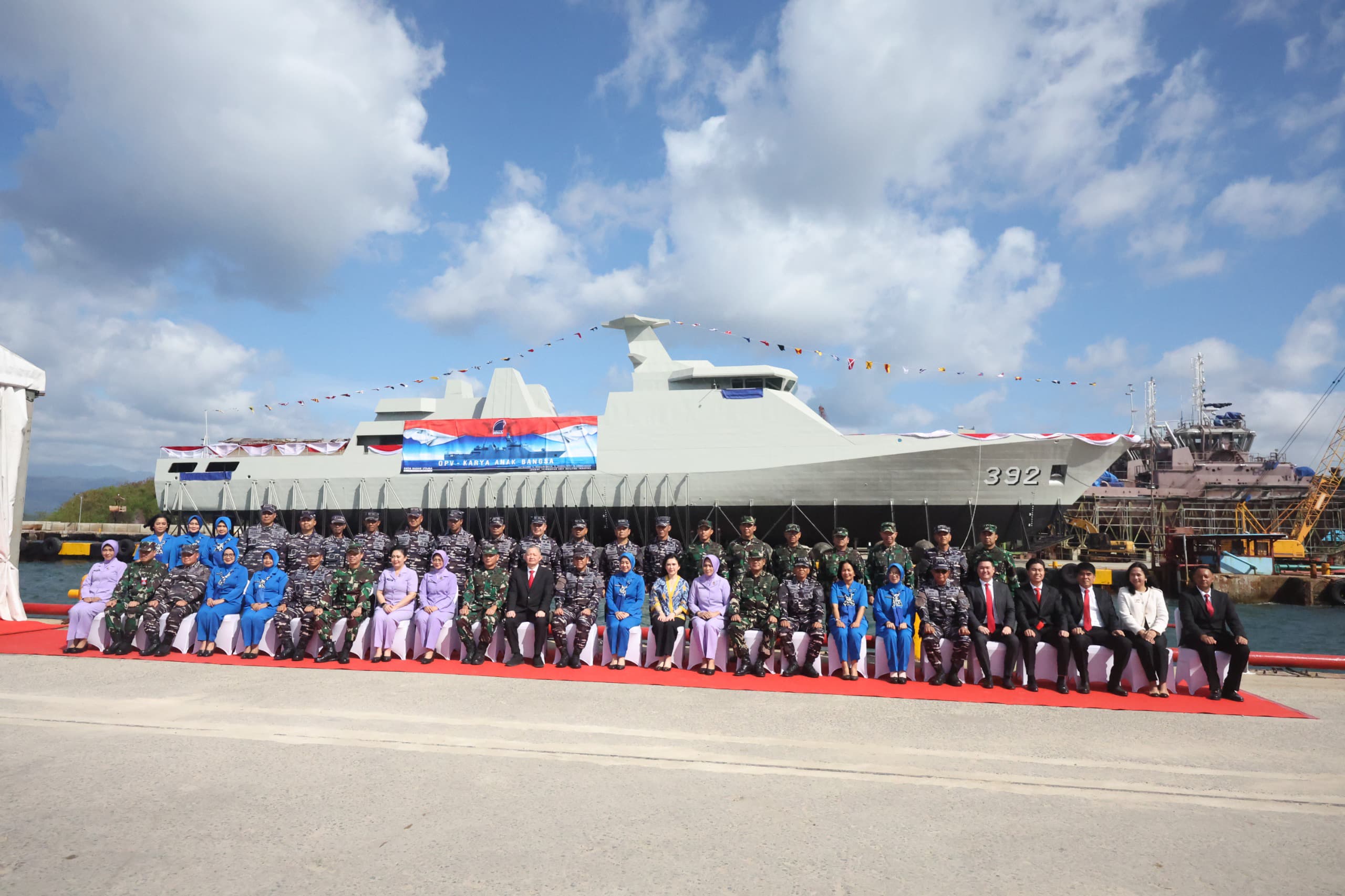The Indonesian Ministry of Defense, in collaboration with PT Daya Radar Utama (DRU), has launched two new state-of-the-art Offshore Patrol Vessels (OPVs). The vessels, named KRI Raja Haji Fisabilillah (391) and KRI Lukas Rumkorem (392), were officially launched at a ceremony held at the DRU shipyard in Lampung on September 20. The event, presided over by Admiral Muhammad Ali, Chief of Staff of the Indonesian Navy (TNI AL), marks a pivotal step in Indonesia’s long-term strategic plan to modernize its naval fleet and enhance the country’s maritime security infrastructure. The KRI Raja Haji Fisabilillah and KRI Lukas Rumkorem are part of Indonesia’s larger initiative to bolster its naval presence in its vast maritime jurisdiction, which spans thousands of islands and some of the busiest sea lanes in the world. These OPVs, with a length of 90 meters, are designed to fulfill multiple roles, including high-speed patrol operations, combat missions, and maritime security tasks. Each vessel has been constructed with a monohull design, enabling them to maintain exceptional performance even at high speeds, with a maximum speed of 28 knots and a cruising speed of approximately 20 knots. The vessels will play a key role in enhancing Indonesia’s maritime domain awareness and security posture, as they are capable of performing a wide array of operations across Indonesia’s extensive territorial waters. Their advanced design allows them to seamlessly transition between combat roles and patrol functions, making them versatile assets in the Indonesian Navy’s fleet.
PT DRU, a leading Indonesian shipbuilding company, was entrusted by the Ministry of Defense to build these OPVs, marking a significant achievement in Indonesia’s defense industry. This development is part of a broader effort to reduce dependency on foreign defense contractors and promote self-reliance in the production of critical military assets. The KRI Raja Haji Fisabilillah and KRI Lukas Rumkorem are not just patrol vessels; they are equipped with an array of sophisticated weaponry and sensor systems that elevate them to the level of light frigates. According to the Director of PT DRU, these vessels are equipped to handle air, surface, and underwater threats, making them formidable platforms capable of both defensive and offensive operations. With this configuration, the OPVs can function not only as patrol ships but also as strike vessels, significantly enhancing the firepower of the Indonesian Navy. The OPVs are outfitted with a wide range of modern weapons systems. Among these is the Rheinmetall Millennium 35mm rapid-fire gun mounted atop the vessel’s hangar, providing it with effective close-range defense against incoming aerial and surface threats. Additionally, the vessels are equipped with 2×4 anti-ship missile launchers located on the midship deck, as well as the highly effective OTO Melara 76mm Super Rapid Gun, which is positioned on the bow of the ship for long-range engagement of surface targets. The vessels have been designed according to the “Fitted For But Not With” (FFBNW) concept, meaning that they can be equipped with additional weapons and systems as needed in the future. This provides flexibility for future upgrades, allowing the Indonesian Navy to adapt the vessels for new missions or technological advancements over time.

The launch of these OPVs is a key element of Indonesia’s long-term defense strategy, which aims to modernize the Indonesian Navy (TNI AL) and position it as a credible force in the region. The vessels form part of a broader effort to address the gap between smaller patrol ships and larger warships like corvettes and frigates. As such, the OPVs are intended to support both the Patrol Fleet Command (Satrol) and the Escort Fleet Command (Satkor), enhancing the Navy’s ability to conduct high-seas operations, protect critical sea lanes, and respond to security threats in both coastal and offshore areas. These new vessels align with the Ministry of Defense’s broader vision of creating a modern navy that is not only capable of defending Indonesia’s territorial waters but also able to project power regionally and participate in international operations when necessary. Beyond their impressive armament, the OPVs are equipped with features that enable a range of naval operations. Both vessels include a helipad and hangar capable of supporting helicopter operations, which is critical for extending their operational reach and enhancing their ability to perform maritime surveillance, search and rescue missions, and anti-submarine warfare. The vessels are also fitted with two RHIB (Rigid Hull Inflatable Boats) launch ramps at the stern, allowing for swift deployment of boarding teams during Visit, Board, Search, and Seizure (VBSS) operations. The strategic focus on building OPVs also reflects Indonesia’s recognition of the growing importance of maritime security in Southeast Asia, where regional powers such as Malaysia, Thailand, Singapore, and Australia are similarly investing in upgrading their naval capabilities.
The OPVs are equipped with features that enable a range of naval operations. Both vessels include a helipad and hangar capable of supporting helicopter operations, which is critical for extending their operational reach and enhancing their ability to perform maritime surveillance, search and rescue missions, and anti-submarine warfare. The vessels are also fitted with two RHIB (Rigid Hull Inflatable Boats) launch ramps at the stern, allowing for swift deployment of boarding teams during Visit, Board, Search, and Seizure (VBSS) operations. The OPVs’ capacity to support these diverse operations makes them essential assets for Indonesia’s maritime security, particularly in monitoring and safeguarding critical sea routes, countering piracy, and conducting maritime law enforcement activities. Their speed, versatility, and advanced combat capabilities make them ideal for both peacetime patrol missions and wartime engagements. As the KRI Raja Haji Fisabilillah (RHF)-391 and KRI Lukas Rumkorem (LRK)-392 undergo final outfitting and sea trials, their launch marks a significant achievement in Indonesia’s quest to modernize its naval forces and assert its presence in the increasingly contested waters of Southeast Asia. These advanced Offshore Patrol Vessels will enhance Indonesia’s ability to protect its vast maritime domain, strengthen its maritime defense capabilities, and project power across the region.















